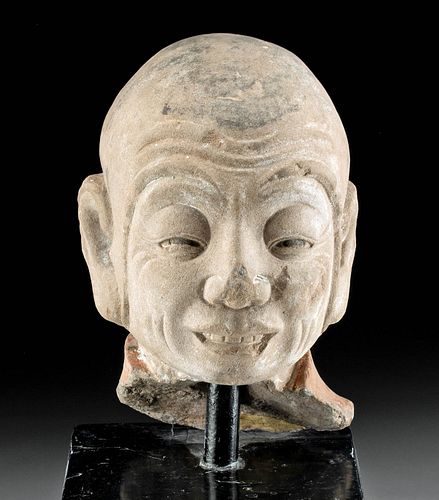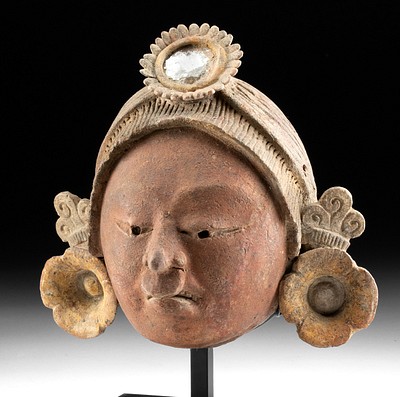Lifesize Chinese Song Stone Head Lohan / Arhat
Lot 74
About Seller
Artemis Gallery
686 S Taylor Ave, Ste 106
Louisville, CO 80027
United States
Selling antiquities, ancient and ethnographic art online since 1993, Artemis Gallery specializes in Classical Antiquities (Egyptian, Greek, Roman, Near Eastern), Asian, Pre-Columbian, African / Tribal / Oceanographic art. Our extensive inventory includes pottery, stone, metal, wood, glass and textil...Read more
Categories
Estimate:
$5,500 - $8,250
Absentee vs Live bid
Two ways to bid:
- Leave a max absentee bid and the platform will bid on your behalf up to your maximum bid during the live auction.
- Bid live during the auction and your bids will be submitted real-time to the auctioneer.
Bid Increments
| Price | Bid Increment |
|---|---|
| $0 | $25 |
| $300 | $50 |
| $1,000 | $100 |
| $2,000 | $250 |
| $5,000 | $500 |
| $10,000 | $1,000 |
| $20,000 | $2,500 |
| $50,000 | $5,000 |
| $100,000 | $10,000 |
| $200,000 | $20,000 |
About Auction
By Artemis Gallery
Jul 14, 2022
Set Reminder
2022-07-14 10:00:00
2022-07-14 10:00:00
America/New_York
Bidsquare
Bidsquare : Exceptional Antiquities Ethnographica Fine Art
https://www.bidsquare.com/auctions/artemis-gallery/exceptional-antiquities-ethnographica-fine-art-9692
Museum-worthy examples of classical antiquities (Egyptian, Greek, Roman, Near Eastern), Viking, Far East / Asian, Pre-Columbian, African / Tribal, Oceanic, Native American, Spanish Colonial, Fossils, Ancient Jewelry, Fine / Visual Arts, so much more! Artemis Gallery info@artemisgallery.com
Museum-worthy examples of classical antiquities (Egyptian, Greek, Roman, Near Eastern), Viking, Far East / Asian, Pre-Columbian, African / Tribal, Oceanic, Native American, Spanish Colonial, Fossils, Ancient Jewelry, Fine / Visual Arts, so much more! Artemis Gallery info@artemisgallery.com
- Lot Description
East Asia, China, Song Dynasty, ca. 960 to 1270 CE. Hand-carved from a large piece of grey stone, an exceptional, life-size head of the Lohan or Arhat - one of Buddha's original followers - known as Asita or "Long Eyebrow Lohan," presenting a tranquil, meditative countenance, a high collar, and elongated ears, all enveloped in traces of white, red, and black, pigments. Rendered in remarkable realism, the sculpture displays slender eyes, arched brows that extend down the sides of the face, a broad nose, and fleshy, gently-parted lips held in a gentle smile. Note the careful detail with which the artist has depicted the fleshy folds of the forehead, puffy surroundings of the eyes, radiating crow's feet, and charming dimples, all imbuing the figure with a lifelike vibrancy! Size: 7" W x 10.2" H (17.8 cm x 25.9 cm); 16.6" H (42.2 cm) on included custom stand.
Lohan, also called Arhat, means a Buddhist ascetic; the word is a transliteration of Sanskrit and came from India. Paintings and sculptures of Lohan figures emerged during the Tang Dynasty (618 to 907 CE) and became popular - and refined - during the Song. Stone sculptures like this one were made to adorn huge Buddhist cave temples cut out of the mountains of northern and central China. Lohans are known for possessing immense wisdom, fortitude, bravery in the face of evil, and supernatural powers. They have become known as the guardian angels of Buddhist temples. In Mahayana Buddhism, Arhats (or Lohans in Chinese) were understood as the original followers of Buddha who followed the Eightfold Path and attained the Four Stages of Enlightenment and deliverance from mere earthly existence. Arhats have successfully arrived at what is known as the 'other shore' and are at peace for all eternity. Gone are all 'asavas' or desires for sensual pleasure, incorrect viewpoints, and ignorance. In other Buddhist traditions the term has been used for people far advanced along the path of Enlightenment but who have not reached full Buddhahood. A striking example of this revered spiritual being.
Provenance: private Hawaii, USA collection, 1995 to 2010; ex-M. Kobiashi collection, Hawaii, USA, acquired from 1950 to 2000
All items legal to buy/sell under U.S. Statute covering cultural patrimony Code 2600, CHAPTER 14, and are guaranteed to be as described or your money back.
A Certificate of Authenticity will accompany all winning bids.
PLEASE NOTE: Due to recent increases of shipments being seized by Australian & German customs (even for items with pre-UNESCO provenance), we will no longer ship most antiquities and ancient Chinese art to Australia & Germany. For categories of items that are acceptable to ship to Australia or Germany, please contact us directly or work with your local customs brokerage firm.
Display stands not described as included/custom in the item description are for photography purposes only and will not be included with the item upon shipping.
#172801Fragment of a larger piece. Chipping to ears, nose, left cheek, and lip. Expected surface wear with some nick and abrasions to areas. Otherwise, excellent with liberal remaining pigments.Condition
- Shipping Info
-
All shipping is handled in-house for your convenience. Your invoice from Artemis Gallery will include shipping calculation instructions. If in doubt, please inquire BEFORE bidding for estimated shipping costs for individual items.
-
- Buyer's Premium



 EUR
EUR CAD
CAD AUD
AUD GBP
GBP MXN
MXN HKD
HKD CNY
CNY MYR
MYR SEK
SEK SGD
SGD CHF
CHF THB
THB













